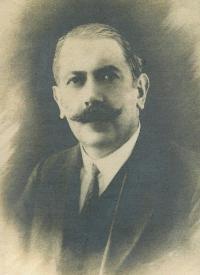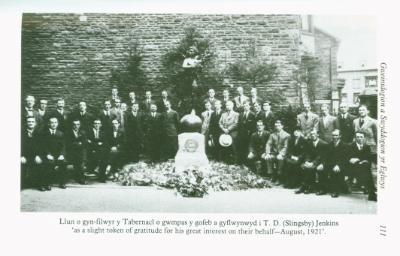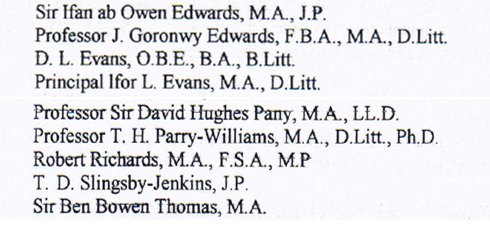Thomas David Jenkins: A Forgotten Philanthropist
Since its foundation Aberystwyth University has been extremely fortunate in its benefactors (see Philanthropy at Aberystwyth University, 1860-1950 by Dr Susan Davies), without whose constant support, politically as well as financially, it would have been difficult for the institution to have survived many of the storms that beset it in its early days.
But not only did the College survive, it flourished and attracted further support from far and wide which enabled it to grow, becoming a leading centre of education and a focus of pride for the people of Aberystwyth, one of whom was T.D. Jenkins.
 Thomas David Jenkins was born on Christmas Day 1872, the year that the College was founded, the eldest son of Evan and Mary Jenkins, Bodhyfryd, Bridge Street. When he was two years old his father was lost at sea but T.D. Jenkins was able to continue with his education. After leaving school he worked in a local solicitor’s office before joining John Mathias and Son, a local shipping firm that also had offices in Cardiff, and Jenkins rose in the company, becoming its Managing Secretary.
Thomas David Jenkins was born on Christmas Day 1872, the year that the College was founded, the eldest son of Evan and Mary Jenkins, Bodhyfryd, Bridge Street. When he was two years old his father was lost at sea but T.D. Jenkins was able to continue with his education. After leaving school he worked in a local solicitor’s office before joining John Mathias and Son, a local shipping firm that also had offices in Cardiff, and Jenkins rose in the company, becoming its Managing Secretary.
His love for Aberystwyth and its institutions was strong. He had endowed a scholarship at Aberystwyth University for local children, and in 1920, when he was 47 years old, he was elected a Life Member of the Court of Governors of the College; in 1922 he became a member of the College Council until his death in 1955. In 1924 he was made a member of the Court of Governors of the National Library of Wales, and from 1932 until his death he was a member of its Council.
He was also a prominent member of Tabernacle Calvinistic Methodist Chapel in the town and had been a teacher of the boys class at its Sunday School. It is not surprising, then, that when 14 of those boys were killed in the First World War, T.D. Jenkins, and others at Tabernacle, wanted to commemorate them. Through his shipping interests T.D. Jenkins often visited Italy and was a great admirer of Italian art, which resulted in the sculptor Mario Rutelli of Palermo being commissioned to work on the monument.
£540 had been raised through donations but the actual cost of the monument was £1,000. During the unveiling ceremony on 6 July 1921 T.D. Jenkins announced that he would pay for the monument and that he would like the money that had been collected for it to be given to the Aberystwyth Infirmary to establish a children’s ward. This was duly done, and on 17 November 1925 T.D. Jenkins himself unveiled a plaque in the North Road Hospital recording that Towards the cost of erecting the PRINCE OF WALES WING at this hospital the sum of £587.9.10d. was contributed by the Tabernacle C.M. Church of this town, the contribution being made in affectionate remembrance of the members of the church who fell in the GREAT WAR 1914-1918, and in recognition of the establishment of a Children’s Ward in the hospital, December 1924.

T.D. Slingsby-Jenkins and some of the former Tabernacle soldiers with Mario Rutelli’s monument to commemorate the 14 that died in the First World War.
In addition to ensuring that the Tabernacle commemoration fund money went towards the children’s ward, it is very likely that T.D. Jenkins also had a part in naming the ward, the Prince of Wales Wing. As we recorded in last month’s blog, The Whitewashed Prince, T.D. Jenkins admired the Duke of Windsor and paid for his statue at Old College which was unveiled in December 1922. That statue was also the work of Mario Rutelli, but he and T.D. Jenkins, indirectly and directly, were also responsible for another two monuments in Aberystwyth.
When Marion Rutelli visited the town to work on the Tabernacle statue, the Aberystwyth War Memorial Committee were in some difficulty as Harvard Thomas, the original sculptor who had been commissioned for the Aberystwyth memorial, had died soon after his first presentation to the committee. The committee asked Rutelli if he would prepare some drawings for the town memorial and it is this one which was unveiled on Castle Point on 14 September 1923 and ‘is considered by some to be one of the finest in Britain’.
The fourth and last statue that T.D. Jenkins and Mario Rutelli were responsible for is the marble statue of Sir John Williams that was unveiled at the National Library of Wales on 4 October 1924. Sir John Williams, who had been Queen Victoria’s physician, was one of the main founders of the Library and whose gift of books and manuscripts ensured that it came to Aberystwyth. He was also President of Aberystwyth University between 1913 and 1926 and T.D. Jenkins admired him as much as he admired Prince Edward.
But T.D. Jenkins’ service to Aberystwyth and Wales went beyond the University and the National Library; he was a Justice of the Peace on the Llanbadarn Bench, High Sheriff for Cardiganshire in 1931 and Vice-president of Urdd Gobaith Cymru.
And his contribution to Welsh life went beyond Wales. In 1937 he married Roma Beatrice Evlyn Marie Slingsby and added ‘Slingsby’ to his name, becoming known as T.D. Slingsby-Jenkins from then on. They had homes in Devil’s Bridge, Porth Elenydd, and London. Their London address was 9 Victoria Square (Ian Fleming lived at no. 16) and while they lived there T.D. was very involved in London Welsh activities. He was a member of the Cymmrodorion Society for over 35 years, and in 1951, when the Society was granted a Royal Charter on the occasion of its 250th anniversary, T.D. Slingsby-Jenkins was on the Council. Amongst the other 30 members were Ifan ab Owen Edwards, Ifor Evans, David Hughes-Parry, T.H. Parry-Williams and Ben Bowen Thomas, all prominent national public figures with strong Aberystwyth connections.

He was Treasurer of the Society from 1934 to 1949 and was Vice-President in 1953. These are considered ‘the most vital and active years in the history of the Society’ with the publication of the Dictionary of Welsh Biography a high point, to which T.D. Slingsby-Jenkins ‘contributed generously towards’ the costs.
He was a member of the Board of the British Sailors' Society to which he also showed great generosity.
His Italian business connections resulted in him being honoured in 1940 when King Victor Emmanuell III awarded him the ‘Commendatore of the Order of the Crown of Italy’ for his work in promoting friendship between Italy and Britain. The death of his wife Roma in 1948 was a sad blow to T.D. Slingsby-Jenkins, and due to ill health he spent most of his winters on the Mediterranean. It was there at the Villa Carla, Imperia on the Italian Riviera that he died on 5 April 1955.

But this remarkable story has one final surprise. On 3 March 1955, 24 days before his death, 82 year old T.D. Slingsby-Jenkins married Margherita Vita, the 29 year old grand-daughter of a business friend and it was she who inherited his estate of £50,000 (c£1.5 million today). This naturally raised eyebrows and was widely reported.
Thomas and Roma Slingsby-Jenkins had no children and his marriage to Margherita Vita invalidated any last will and testament that he had made, but it would be very interesting to know if any local institutions, societies or charities would have benefited from the generosity of this largely forgotten Aberystwyth philanthropist.
SOURCES
Brynley F. Roberts, ‘Syr John a’r Eidalwr’ in Essays and Poems presented to Daniel Huws, edited by Tegwyn Jones and E.B. Fryde. Aberystwyth: The National Library of Wales, 1994.
Moelwyn I. Williams Y Tabernacl Aberystwyth, 1785-1985. Aberystwyth: Cyhoeddedig gan yr awdur, 1986.
Sir John Cecil-Williams, LL.D., ‘T. D. Slingsby-Jenkins’ The Transactions of the Honourable Society of Cymmrodorion, 1956, pp.70-72.
